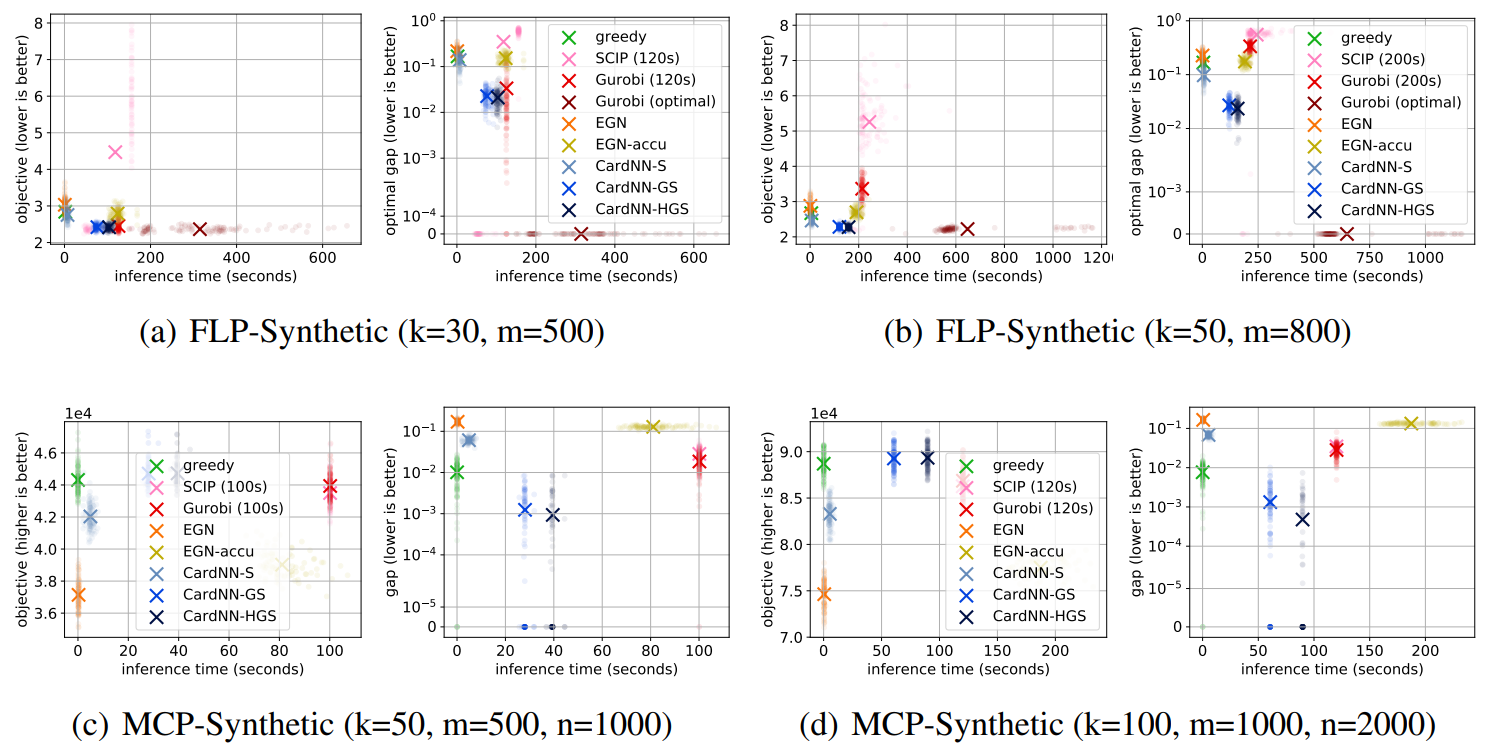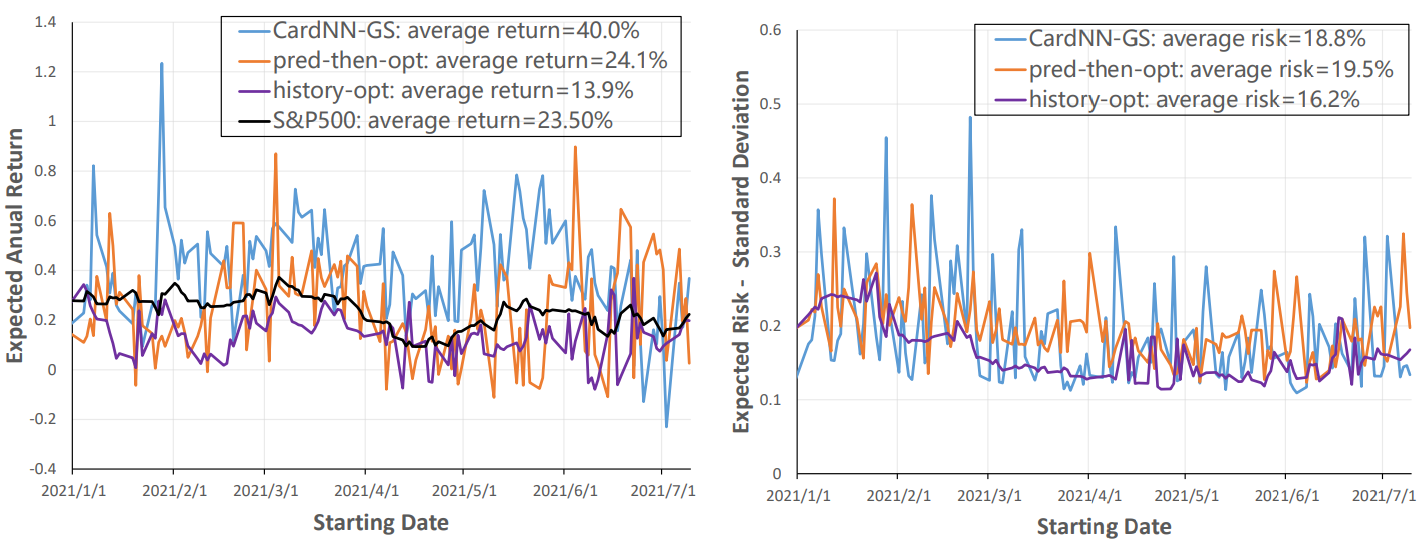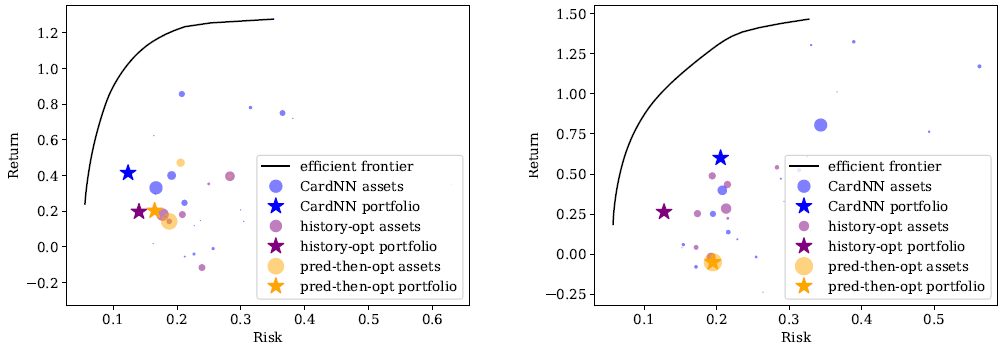This is the official implementation of our ICLR 2023 paper "Towards One-shot Neural Combinatorial Solvers: Theoretical and Empirical Notes on the Cardinality-Constrained Case".
This work is jointly done by ThinkLab@SJTU and JD Explore Academy.
This repository offers neural network solvers, datasets, training and evaluation protocols for three cardinality-constrained combinatorial optimization problems:
- Facility Location Problem (FLP), on synthetic data and real-world Starbucks locations;
- Max Covering Problem (MCP), on synthetic data and real-world Twitch datasets;
- Portfolio Optimization (PortOpt), on real-world stock prices in 2021.
As read from the title, our ultimate goal is building one-shot neural combinatorial solvers: a neural network whose input is the parameters of a combinatorial optimization (CO) problem, and whose output is the solution (i.e. the decision variables). The neural network is expected to output the solution in one-shot, instead of a tedious multi-step auto-regressive manner. We believe such one-shot neural solvers have the following advantages over traditional solvers:
- Higher efficiency (neural solvers on GPU vs traditional solvers on CPU)
- Enabling joint predict-and-optimize paradigms (differentiable neural solvers vs usually non-differentiable traditional solvers)
Towards the ultimate goal, we identify the following technical challenges: the output of neural networks is usually unconstrained, yet the solutions to combinatorial optimization usually have complicated constraints. Besides, the discrete nature of combinatorial constraints conflicts with the continuous nature of neural networks. To resolve these issues, this paper champions the following methodology: softly enforcing constraints to neural networks by a differentiable layer. The overview of such a pipeline is shown as follows.
The key is developing the differentiable constraint layer and designing efficient self-supervised loss (usually by estimating the objective score). Such a flexible design also enables gradient-based update at testing time.
Seeing that a general method to handle all CO problems seems too challenging, this paper focuses on developing a more practical paradigm for solving the cardinality-constrained CO. We present a differentiable layer named CardNN to handle cardinality constraints, which is based on Sinkhorn iterations and Gumbel trick, and conduct theoretical study of the design of the constraint-enforcing layer. We are not diving too deep into the theoretical results of Gumbel-Sinkhorn in this introduction, and here summarizes our main conclusion:
A tighter constraint violation leads to better performance for one-shot neural combinatorial solvers.
We believe such theoretical insights could further generalize to other CO problems beyond cardinality constraints.
In this paper, we compare three ways of handling cardinality constraints, theoretically:
- Erdos Goes Neural (Karalias & Loukas, NeurIPS'20) puts constraint violation as a penalty term in the loss. Theoretically, the neural net's output can be arbitrary thus the constraint violation is unbonded.
- SOFT-TopK (Xie et al., NeurIPS'20) uses Sinkhorn to enforce cardinality constraint, which is equivalent to a TopK selection. SOFT-TopK offers an upper-bound of constraint violation, yet the bound can diverge in the wost case (when k-th and (k+1)-th elements are equal).
- Gumbel-Sinkhorn-TopK (this paper) further addresses the diverging issue in SOFT-TopK. Specifically, the constraint violation can be arbitrarily controlled, and its theoretical upper bound is tighter than SOFT-TopK by introducing the Gumbel trick.
Please see the main paper for the math details. Our experiment shows consistent result with the theoretical study: empirically, we have Erdos Goes Neural (EGN) < SOFT-TopK (CardNN-S) < Gumbel-Sinkhorn-TopK (CardNN-GS). Experiments are conducted on both synthetic problems (in line with most neural CO solver papers), and transfer learning from synthetic problems to real-world instances.
Pure CO problem means the problem parameters are known at the decision-making time. The neural solver should learn to optimize the objective score.
In experiments, considering both efficiency and objective score, our neural solvers can be comparative to state-of-the-art traditional solvers (Gurobi and SCIP), and sometimes can even surpass.
Given m locations, we want to extend k facilities such that the goods can be stored at the nearest facility and delivered more efficiently. Another scenario may be a city with m communities, and we want to build k facilities (like battery swapping stations for e-vehicles) for all residents.
The objective of FLP is to minimize the sum of the distances between each location and its nearest facility. See the paper for the math form.
Given m sets and n objects, each set may cover any number of objects and each object is associated with a value. MCP aims to find k sets (k ≪ m) such that the covered objects have the maximum sum of values. This problem reflects real-world scenarios such as discovering influential seed users in social networks.
See the paper for the math form.
Since there lacks large-scale real-world benchmark for FLP and MCP, we follow most neural CO papers and test our solvers on synthetic data. The synthetic results are shown as follows. Our neural solvers are the blue ones.
We also consider a transfer learning setting with real-world data: neural networks are firstly learned with synthetic data, and then tested on real-world datasets. The real-world datasets are collected from the Starbucks locations in London, New York, Shanghai, Seoul with 166-569 stores, and the social network collected from Twitch. Our neural solvers surpasses Gurobi & SCIP on FLP. On MCP, our neural solvers are inferior, while it is worth noting that our Homotopy version CardNN-HGS finds all optimal solutions, which is hard to achieve for most previous neural solvers.
Predictive CO problem means the problem parameters are unknown at the decision-making time. We consider the portfolio optimization problem as an example: when making an investment, we cannot know the returns/risks of assets in the future. The only feasible way is predicting the future returns/risks, while such prediction always contains errors. If the optimizer is unaware of such prediction error, even the optimal solution does not reflect the optimal decision in the future, and it is very likely that the optimizer is misled by the prediction error.
The above challenge give rise to the recent research topic of joint "predict and optimize", and here we show that our neural solver also owns the flexibility to handle predictive CO by jointly learning a neural predictor and a neural solver end-to-end.
Cardinality constrained portfolio optimization considers a practical scenario where a portfolio must contain no more than k assets. Restricting the number of assets in a portfolio can reduce operational costs. A good portfolio should have a high return (measured by mean vector µ) and low risk (measured by covariance matrix Σ).
In this paper, we refer to maximizing the Nobel-prize-winning Sharpe ratio (see the paper for the math form). An LSTM is built as the predictor, followed by fully-connected layers as the neural solver.
We test on the real prices of S&P 500 assets in 2021. The joint predict-and-optimize method based on our CardNN-GS outperforms others with higher returns and lower risks.
Visualization also shows that the portfolio built by CardNN-GS is closer to the efficient frontier. And note that reaching the efficient frontier is nearly impossible in practice because we do not know the real returns/risks at the decision-making time.
To run the code, first install torch and torch_geometric according to the official
docs ([PyTorch], [Geometric]).
The versions we used are torch==1.6.0 and torch-geometric==1.6.3, and we think any
newer versions will work too. If you face any issues during installation, there are many
online resources available.
Then install the following Python packages:
pip install ortools easydict matplotlib yfinance pandas cvxpylayers xlwt
Follow the next steps and you shall reproduce the main results in our paper.
Note: If you are seeing results way inferior to our paper, it is probably a reason of random seeds. Please delete the model weights and train the model again.
On synthetic data, 500 locations.
python facility_location_experiment.py --cfg cfg/facility_location_rand500.yamlOn synthetic data, 800 locations.
python facility_location_experiment.py --cfg cfg/facility_location_rand800.yamlOn real-world data (Starbucks), distance measured by Euclidean distance.
python facility_location_experiment.py --cfg cfg/facility_location_starbucks_euclidean.yamlOn real-world data (Starbucks), distance measured by Manhattan distance.
python facility_location_experiment.py --cfg cfg/facility_location_starbucks_manhattan.yamlOn synthetic data, 500 sets and 1000 items.
python max_covering_experiment.py --cfg cfg/max_cover_rand500.yamlOn synthetic data, 1000 sets and 2000 items.
python max_covering_experiment.py --cfg cfg/max_cover_rand1000.yamlOn real-world data (Twitch social network).
python max_covering_experiment.py --cfg cfg/max_cover_twitch.yamlNote that portfolio optimization experiment does not offer a configuration system. Some hyperparameters
are coded at the beginning of portfolio_opt_experiment.py.
Training:
python portfolio_opt_experiment.py --train --method predict-and-opt--method can be selected from predict-and-opt (LSTM+our CardNN-GS), predict-then-opt
(LSTM+Gurobi), history-opt. You need to install gurobipy and have a valid license to run
predict-then-opt.
After training, load a checkpoint (at 55-th epoch here) and run testing:
python portfolio_opt_experiment.py --start_epoch 55 --method predict-and-optIf you find our paper/code useful in your research, please cite
@inproceedings{wang2023cardinality,
title={Towards One-shot Neural Combinatorial Solvers: Theoretical and Empirical Notes on the Cardinality-Constrained Case},
author={Runzhong Wang and Li Shen and Yiting Chen and Xiaokang Yang and Junchi Yan},
year={2023},
booktitle={ICLR}
}




